50. Moira, The Handmaid’s Tale
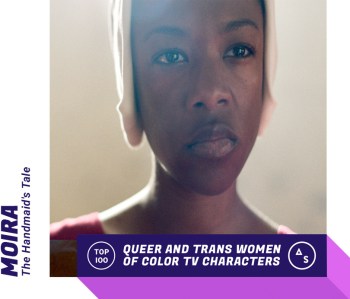 Since the Gillead took over the United States, Moira has been forced into a life that she never imagined for herself (and most of us would consider a living nightmare). She’s been under the constant threat of death because she’s a lesbian, she’s been forced into sex work against her will, she’s had to commit murder. She also never lost her will to fight back. Every chance Moira’s had to run, to live another day, to choose herself and her freedom — she’s done just that. And now that she’s made it to the American refugee community in Canada, her fight has only gotten stronger. There isn’t a protest she won’t attend, an elected official she won’t go to directly in their face. She’ll stop at nothing to make sure others know the traumas she’s had to survive, so that maybe — just maybe — someone else won’t have to through it, too. (Did I mention Samira Wiley finally won her long deserved Emmy while playing this role?) — Carmen
Since the Gillead took over the United States, Moira has been forced into a life that she never imagined for herself (and most of us would consider a living nightmare). She’s been under the constant threat of death because she’s a lesbian, she’s been forced into sex work against her will, she’s had to commit murder. She also never lost her will to fight back. Every chance Moira’s had to run, to live another day, to choose herself and her freedom — she’s done just that. And now that she’s made it to the American refugee community in Canada, her fight has only gotten stronger. There isn’t a protest she won’t attend, an elected official she won’t go to directly in their face. She’ll stop at nothing to make sure others know the traumas she’s had to survive, so that maybe — just maybe — someone else won’t have to through it, too. (Did I mention Samira Wiley finally won her long deserved Emmy while playing this role?) — Carmen
49. Adena El-Amin, The Bold Type
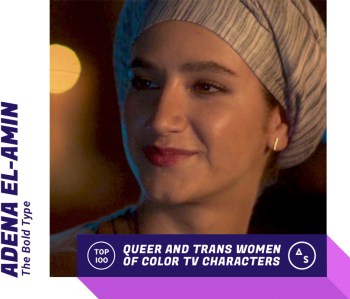 Can I tell you a quick secret? Adena El-Amin’s actually the reason I started watching The Bold Type to begin with. Despite knowing muslim queer women who wore their hair covered in my actual life; I had never seen one before on television. Right away Adena complicated misinformed narratives about Islam and the choices muslim women make to honor their faith. She also dealt with real immigration problems and red tape and anxieties around being a queer immigrant that’s familiar to so many. On top of all that, Adena was give space to just be a full person. She’s sexy, insecure at times, an artist. She isn’t merely broadly painted tropes and that’s what makes it so easy for us (and Kat) to fall in love with her. — Carmen
Can I tell you a quick secret? Adena El-Amin’s actually the reason I started watching The Bold Type to begin with. Despite knowing muslim queer women who wore their hair covered in my actual life; I had never seen one before on television. Right away Adena complicated misinformed narratives about Islam and the choices muslim women make to honor their faith. She also dealt with real immigration problems and red tape and anxieties around being a queer immigrant that’s familiar to so many. On top of all that, Adena was give space to just be a full person. She’s sexy, insecure at times, an artist. She isn’t merely broadly painted tropes and that’s what makes it so easy for us (and Kat) to fall in love with her. — Carmen
48. Luisa Alvar, Jane the Virgin
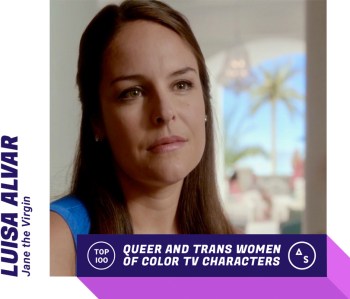 If we’re being honest, we probably shouldn’t love Luisa as much as we do, but even through Jane the Virgin‘s most spectacular moments — like when Rose and Luisa disappear their underwater submarine hideout — there’s something so pure about her. She wants so desperately to be seen and to be loved and you almost can’t help but wanting it for her. Sure, would I rather have it be with someone that didn’t deem Luisa delusional and have her committed to hide their relationship? Absolutely, but, you know, the heart wants what the heart wants… and the greatest love story ever told would not be denied. — Natalie
If we’re being honest, we probably shouldn’t love Luisa as much as we do, but even through Jane the Virgin‘s most spectacular moments — like when Rose and Luisa disappear their underwater submarine hideout — there’s something so pure about her. She wants so desperately to be seen and to be loved and you almost can’t help but wanting it for her. Sure, would I rather have it be with someone that didn’t deem Luisa delusional and have her committed to hide their relationship? Absolutely, but, you know, the heart wants what the heart wants… and the greatest love story ever told would not be denied. — Natalie
47. Melanie “Mel” Vera, Charmed
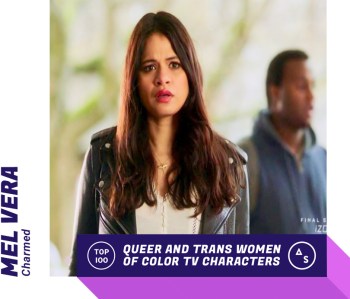 It was a risk rebooting a classic series like Charmed, already beloved by so many queer women. When they announced that all the sisters would be women of color, we were intrigued. Then we learned that one of the sisters would be gay (SOLD!) and played by Melonie Diaz (BONUS!), we knew we’d definitely be watching. Right away, we fell in love with Mel Vera, the leather jacket wearing gender studies grad student (natch) who moonlights as a bartender and the witchy savior of the universe. Over Charmed’s first season, we loved seeing her bond to her sisters and her connection to not one, but two other queer characters of color, deepen with each episode. — Natalie
It was a risk rebooting a classic series like Charmed, already beloved by so many queer women. When they announced that all the sisters would be women of color, we were intrigued. Then we learned that one of the sisters would be gay (SOLD!) and played by Melonie Diaz (BONUS!), we knew we’d definitely be watching. Right away, we fell in love with Mel Vera, the leather jacket wearing gender studies grad student (natch) who moonlights as a bartender and the witchy savior of the universe. Over Charmed’s first season, we loved seeing her bond to her sisters and her connection to not one, but two other queer characters of color, deepen with each episode. — Natalie
46. Tasha Williams, The L Word
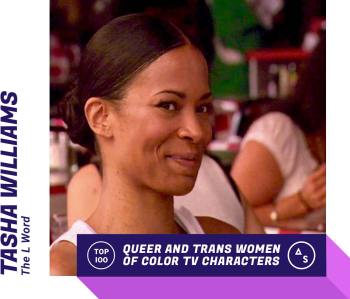 Tasha arrived to The L Word just as the complaints of the show’s whiteness was hitting a crescendo. Alice’s eventual love interest, the army vet (one of the first of her kind on television, airing during the peak of debates regarding “Don’t Ask, Don’t Tell”) was meant to provide a different point of view than the rest of the West Hollywood regulars that populated the show. Tasha spent a lot of time with Alice, but she also had black and Latinx friends outside of their relationship and the show’s narrative. She served her country not because of some stereotype that it’s the only way out of poor black communities, but because she believed in patriotism and freedom. You know what I’ve always loved about Rose Rollins interpretation of Tasha? How often she rolls her eyes quietly in the back and you can just hear her thinking “these crazy rich white women.” That’s real shit. (and definitely the kind of lesbian representation I’m looking for.) — Carmen
Tasha arrived to The L Word just as the complaints of the show’s whiteness was hitting a crescendo. Alice’s eventual love interest, the army vet (one of the first of her kind on television, airing during the peak of debates regarding “Don’t Ask, Don’t Tell”) was meant to provide a different point of view than the rest of the West Hollywood regulars that populated the show. Tasha spent a lot of time with Alice, but she also had black and Latinx friends outside of their relationship and the show’s narrative. She served her country not because of some stereotype that it’s the only way out of poor black communities, but because she believed in patriotism and freedom. You know what I’ve always loved about Rose Rollins interpretation of Tasha? How often she rolls her eyes quietly in the back and you can just hear her thinking “these crazy rich white women.” That’s real shit. (and definitely the kind of lesbian representation I’m looking for.) — Carmen
45. Delle Seyah Kendry, Killjoys
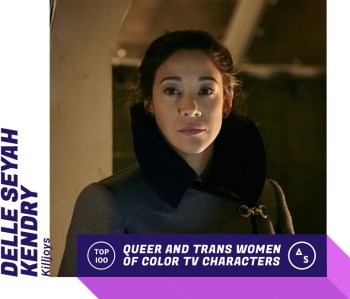 By all accounts, Delle Seyah Kendry should be hated. She has done some heinous things — stabbing Pawter Simms to death, chief among them. She is ruthless and there is, virtually, no ends she won’t go through to get what she wants. And yet, somehow Killjoys fans still find themselves rooting for the character…in large part because the love of her son, Jaq, and Aneela ground her…but also? Who doesn’t like to see a queer character kick a little ass every now and then? — Natalie
By all accounts, Delle Seyah Kendry should be hated. She has done some heinous things — stabbing Pawter Simms to death, chief among them. She is ruthless and there is, virtually, no ends she won’t go through to get what she wants. And yet, somehow Killjoys fans still find themselves rooting for the character…in large part because the love of her son, Jaq, and Aneela ground her…but also? Who doesn’t like to see a queer character kick a little ass every now and then? — Natalie
44. Arthie Premkumar, G.L.O.W.
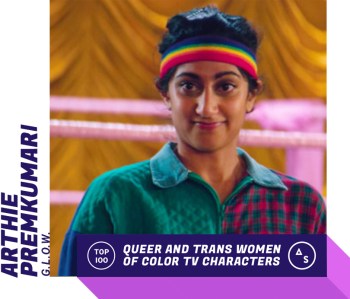 Arthie Premkumar and Yolanda Rivas, the latest addition to the GLOW roster, become roommates during G.L.O.W.‘s second season. And though they couldn’t be more dissimilar — Arthie is quiet and reserved, suffocating under the weight of her family’s expectation that she become a doctor, while Yolanda lives her life freely and openly — Arthie starts to develop feelings for her new roommate and falls in love during their dream ballet. They close out the season with a kiss and begin the third season in a full-fledged relationship. — Natalie
Arthie Premkumar and Yolanda Rivas, the latest addition to the GLOW roster, become roommates during G.L.O.W.‘s second season. And though they couldn’t be more dissimilar — Arthie is quiet and reserved, suffocating under the weight of her family’s expectation that she become a doctor, while Yolanda lives her life freely and openly — Arthie starts to develop feelings for her new roommate and falls in love during their dream ballet. They close out the season with a kiss and begin the third season in a full-fledged relationship. — Natalie
43. Grace Choi, Black Lightning
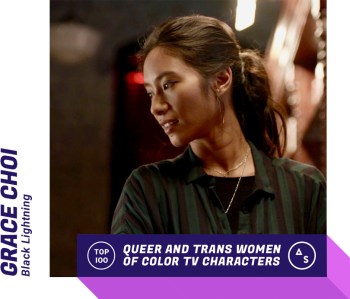 It starts with a little flirtation: Grace Choi happens upon Anissa Pierce while putting away books at the bookstore and a conversation sparks between them. That meet-cute leads to dancing which leads to a romance… and, for a while, that was all. Slowly though, Black Lightning is creating an identity for Grace outside of being Anissa’s love interest: She’s a shapeshifter who can assume the forms of her teenage self, an old man and a leopard. She’s a survivor of human trafficking. Fingers crossed that as Grace learns to harness her powers, the television show follows the comics’ lead and allows them both to be “young folks with outsized powers traveling the world, knocking bad guys on their asses.” — Natalie
It starts with a little flirtation: Grace Choi happens upon Anissa Pierce while putting away books at the bookstore and a conversation sparks between them. That meet-cute leads to dancing which leads to a romance… and, for a while, that was all. Slowly though, Black Lightning is creating an identity for Grace outside of being Anissa’s love interest: She’s a shapeshifter who can assume the forms of her teenage self, an old man and a leopard. She’s a survivor of human trafficking. Fingers crossed that as Grace learns to harness her powers, the television show follows the comics’ lead and allows them both to be “young folks with outsized powers traveling the world, knocking bad guys on their asses.” — Natalie
42. Rue Bennett, Euphoria
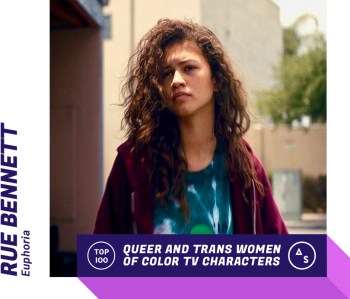 At 11, Rue Bennett had an anxiety attack that sent her to the hospital, where they treated her with liquid valium. The admittedly unreliable narrator admits the drug gave her “this is the feeling I have been searching for my entire life…because suddenly, the world went quiet. And I felt safe, in my own head.” In the six years since that first dose, Rue has been chasing that feeling, looking for the right dose of something to make the world go quiet. She comes too close to silencing the world and herself when she overdoses and nearly chokes on her own vomit but her sister finds her in time. Euphoria picks up soon after Rue’s discharge from rehab, chronicling her messy coming of age a queer teen. — Natalie
At 11, Rue Bennett had an anxiety attack that sent her to the hospital, where they treated her with liquid valium. The admittedly unreliable narrator admits the drug gave her “this is the feeling I have been searching for my entire life…because suddenly, the world went quiet. And I felt safe, in my own head.” In the six years since that first dose, Rue has been chasing that feeling, looking for the right dose of something to make the world go quiet. She comes too close to silencing the world and herself when she overdoses and nearly chokes on her own vomit but her sister finds her in time. Euphoria picks up soon after Rue’s discharge from rehab, chronicling her messy coming of age a queer teen. — Natalie
41. Adriana Mendez, The Bridge
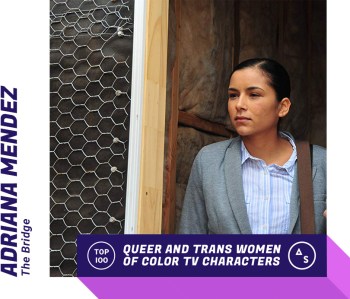 Leading up two Season Two of The Bridge, out actress Emily Rios talked about how important it was to her to normalize her character’s sexuality: “I want it to be an incidental thing, which is what happens in our everyday life… It’s incidental; you don’t ever have to talk about it.” With Adriana Mendez, Rios was able to develop a Latina lesbian reporter — covering a serial killer who’s murdering people on both sides of the border — whose life didn’t come to complete stop just because she was gay. Admittedly there is a fine balance between normalizing and downplaying one’s sexuality. Adriana stands out for finding herself on the right side of that line. — Carmen
Leading up two Season Two of The Bridge, out actress Emily Rios talked about how important it was to her to normalize her character’s sexuality: “I want it to be an incidental thing, which is what happens in our everyday life… It’s incidental; you don’t ever have to talk about it.” With Adriana Mendez, Rios was able to develop a Latina lesbian reporter — covering a serial killer who’s murdering people on both sides of the border — whose life didn’t come to complete stop just because she was gay. Admittedly there is a fine balance between normalizing and downplaying one’s sexuality. Adriana stands out for finding herself on the right side of that line. — Carmen
40. Amanita Caplan, Sense8
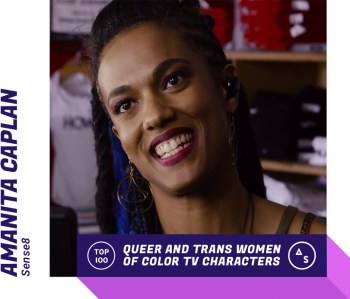 Amanita is extremely kind and open hearted, but don’t get it twisted — she will do what is necessary to protect the people she loves, most explicit her Nominees Marks. Like that time when Nomi experienced a collapsed lung and ends up locked in a hospital? Amanita is right there for her rescue; the two go undercover hiding while they investigate the doctor that planned to lobotomize Nomi to begin with! The FBI continue to pursue Nomi, but Amanita is on her side through it all. Giving us the queer sci-fi Bonnie & Clyde that really do deserve. — Natalie
Amanita is extremely kind and open hearted, but don’t get it twisted — she will do what is necessary to protect the people she loves, most explicit her Nominees Marks. Like that time when Nomi experienced a collapsed lung and ends up locked in a hospital? Amanita is right there for her rescue; the two go undercover hiding while they investigate the doctor that planned to lobotomize Nomi to begin with! The FBI continue to pursue Nomi, but Amanita is on her side through it all. Giving us the queer sci-fi Bonnie & Clyde that really do deserve. — Natalie
39. Devon, I Love Dick
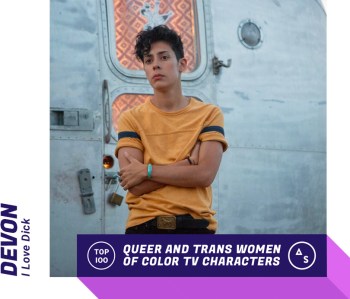 Devon is an unexpected gift in I Love Dick… a original character not featured in Chris Kraus’ source material. She’s the butch Latinx artist and aspiring playwright — who will, no doubt, seduce you with her expressive eyes — living in the trailer behind the house where the protagonist and her husband are having their artists retreat. A local Marfan, Devon grounds the characters around her…a reminder that, for some, this is a home, not just a stop on a journey of exploration. — Natalie
Devon is an unexpected gift in I Love Dick… a original character not featured in Chris Kraus’ source material. She’s the butch Latinx artist and aspiring playwright — who will, no doubt, seduce you with her expressive eyes — living in the trailer behind the house where the protagonist and her husband are having their artists retreat. A local Marfan, Devon grounds the characters around her…a reminder that, for some, this is a home, not just a stop on a journey of exploration. — Natalie
38. Camila Barrios, East Los High
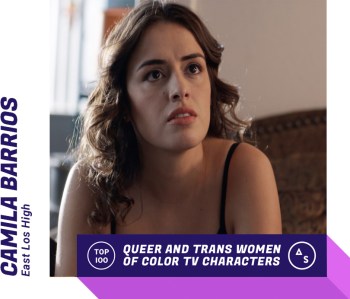 Back when Hulu was still a fledging company and just starting to produce its own original content, there was East Los High. The show, which still retains the title of Hulu’s longest running series to date, made history after being the first English-language series with an all-Latino cast, writers and creators. East Los High‘s second season centered around the tumultous love affair between Jocelyn, a smart, talented aspiring journalist, and Camila, a dance team member with ambitions of making it in the music industry. The storyline earned Camila’s portrayer, Vannessa Vasquez, the show’s first Daytime Emmy nomination. — Natalie
Back when Hulu was still a fledging company and just starting to produce its own original content, there was East Los High. The show, which still retains the title of Hulu’s longest running series to date, made history after being the first English-language series with an all-Latino cast, writers and creators. East Los High‘s second season centered around the tumultous love affair between Jocelyn, a smart, talented aspiring journalist, and Camila, a dance team member with ambitions of making it in the music industry. The storyline earned Camila’s portrayer, Vannessa Vasquez, the show’s first Daytime Emmy nomination. — Natalie
37. Cameron Wirth, Doubt
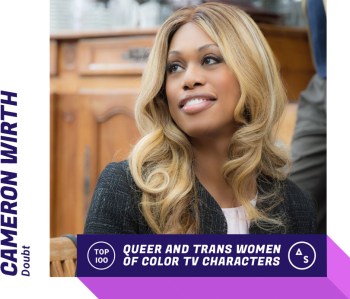 Everything about Laverne Cox’s shortlived turn as Cameron Wirth was groundbreaking: she joined Amiyah Scott as the first two transwomen to be series regulars on broadcast TV. But, for my money, Doubt‘s real triumph was in producing the greatest love story for a trans woman ever told on television (and on CBS, no less). They were never shortchanged: they got to kiss, love, fight, date and make-up just like the show’s other couples. Cameron and Peter fall in love — her overcoming her trepidation and him overcoming his doubts — was like watching a fairytale playing out on my television screen. — Natalie
Everything about Laverne Cox’s shortlived turn as Cameron Wirth was groundbreaking: she joined Amiyah Scott as the first two transwomen to be series regulars on broadcast TV. But, for my money, Doubt‘s real triumph was in producing the greatest love story for a trans woman ever told on television (and on CBS, no less). They were never shortchanged: they got to kiss, love, fight, date and make-up just like the show’s other couples. Cameron and Peter fall in love — her overcoming her trepidation and him overcoming his doubts — was like watching a fairytale playing out on my television screen. — Natalie
36. Jane “J.R.” Ramos, Jane the Virgin
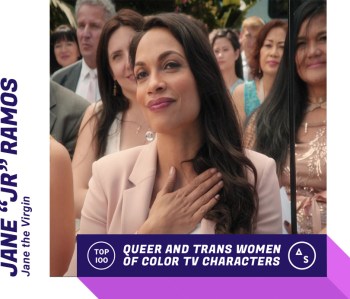 Though in our regular lives, many of us find ourselves in community with other LGBT people, when it comes to TV, we’ve been conditioned to expect there to be only one queer regular character. If another queer character appears on the canvas subsequently, we’re like, “oh, a love interest for the pre-existing gay character.” Jane the Virgin broke new ground: When Jane “J.R.” Ramos showed up, it wasn’t to be a love interest for Luisa, the show’s pre-existing, perpetually unlucky in love, lesbian character, it was to be the catalyst for Petra Solano’s bisexual awakening. — Natalie
Though in our regular lives, many of us find ourselves in community with other LGBT people, when it comes to TV, we’ve been conditioned to expect there to be only one queer regular character. If another queer character appears on the canvas subsequently, we’re like, “oh, a love interest for the pre-existing gay character.” Jane the Virgin broke new ground: When Jane “J.R.” Ramos showed up, it wasn’t to be a love interest for Luisa, the show’s pre-existing, perpetually unlucky in love, lesbian character, it was to be the catalyst for Petra Solano’s bisexual awakening. — Natalie
35. Davina, Transparent
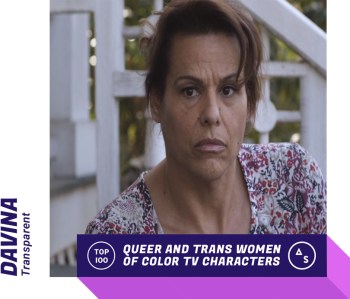 I’m convinced that here’s nothing that Alexandra Billings can’t do. She’s one of the most talented actresses working. With Davina, she’s had a chance to develop an older, working class, often forgotten, HIV positive, trans woman of color and take her from the sidelines of Transparent’s narrative into a role like none other. Davina’s weary from the world, and she’s clear eyed about any tough decisions she has to make, but she also never loses track of the good either. It’s hard to play that optimism without also coming across as naivete (which Davina most assuredly is not), but Alexandra Billings nails it every time.— Carmen
I’m convinced that here’s nothing that Alexandra Billings can’t do. She’s one of the most talented actresses working. With Davina, she’s had a chance to develop an older, working class, often forgotten, HIV positive, trans woman of color and take her from the sidelines of Transparent’s narrative into a role like none other. Davina’s weary from the world, and she’s clear eyed about any tough decisions she has to make, but she also never loses track of the good either. It’s hard to play that optimism without also coming across as naivete (which Davina most assuredly is not), but Alexandra Billings nails it every time.— Carmen
34. Candy Ferocity, Pose
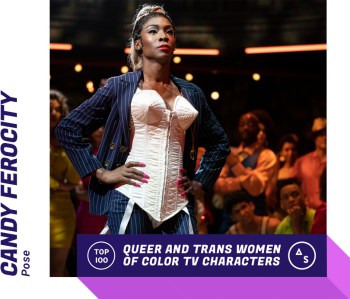 Candy Ferocity takes no shit. She knows her worth and isn’t afraid to go after it. Out of all the girls from Pose, her part admittedly isn’t the largest. But it’s certainly one of the most memorable (and not just because of her death in Season Two, a storytelling decision we’re still rightfully mad about and believe didn’t need to happen at all). What makes Candy stand out is Angelica Ross. The actress has developed Candy’s self-confidence to levels we rarely get to see in trans women on television, particularly for dark skinned trans black women. It’s absolutely Candy’s world. And we’re just candy girls living it. — Carmen
Candy Ferocity takes no shit. She knows her worth and isn’t afraid to go after it. Out of all the girls from Pose, her part admittedly isn’t the largest. But it’s certainly one of the most memorable (and not just because of her death in Season Two, a storytelling decision we’re still rightfully mad about and believe didn’t need to happen at all). What makes Candy stand out is Angelica Ross. The actress has developed Candy’s self-confidence to levels we rarely get to see in trans women on television, particularly for dark skinned trans black women. It’s absolutely Candy’s world. And we’re just candy girls living it. — Carmen
33. Kelsey Phillips, Dear White People
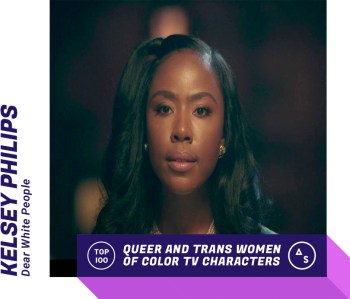 Kelsey Phillips is what we like to call a slow burn. When Dear White People began, she was the background comic relief (there were other black lesbians on the show back then, but… let’s just say, they didn’t make this list for a reason). In Season Two she came out to her roommate Coco with no fanfare. In Season Three, she’s quietly let us all the way into her world. We get to meet her gay friends, we watch her court and fall in love with the cute girl at the coffee shop. We watch as her heart gets broken and she has to pick herself up and try again. All without ever losing the funny quirks that made her such a scene stealer to begin with. — Carmen
Kelsey Phillips is what we like to call a slow burn. When Dear White People began, she was the background comic relief (there were other black lesbians on the show back then, but… let’s just say, they didn’t make this list for a reason). In Season Two she came out to her roommate Coco with no fanfare. In Season Three, she’s quietly let us all the way into her world. We get to meet her gay friends, we watch her court and fall in love with the cute girl at the coffee shop. We watch as her heart gets broken and she has to pick herself up and try again. All without ever losing the funny quirks that made her such a scene stealer to begin with. — Carmen
32. Henrietta “Hen” Wilson, 9-1-1
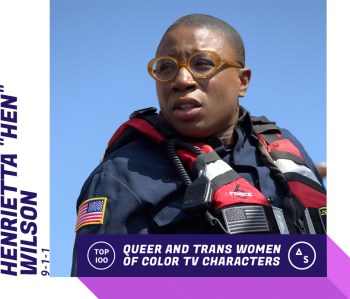 Henrietta Wilson once had a successful career in pharmaceutical sales but she longed for something more. She unwittingly finds her passion when her life coach collapses, mid-session, and Hen has to rush to save her life. Seeking to prolong that adrenaline boost that comes with saving lives, she trains and joins a family of firefighters/paramedics at LA’s Station 118. While her work life is bananas — this is a Ryan Murphy concocted procedural, after all — Hen’s home life grounds the show unlike anything else. 9-1-1 feels the most real when it lives at home with Hen, her wife, Karen, and their son, Denny. — Natalie
Henrietta Wilson once had a successful career in pharmaceutical sales but she longed for something more. She unwittingly finds her passion when her life coach collapses, mid-session, and Hen has to rush to save her life. Seeking to prolong that adrenaline boost that comes with saving lives, she trains and joins a family of firefighters/paramedics at LA’s Station 118. While her work life is bananas — this is a Ryan Murphy concocted procedural, after all — Hen’s home life grounds the show unlike anything else. 9-1-1 feels the most real when it lives at home with Hen, her wife, Karen, and their son, Denny. — Natalie
31. Tara Thornton, True Blood
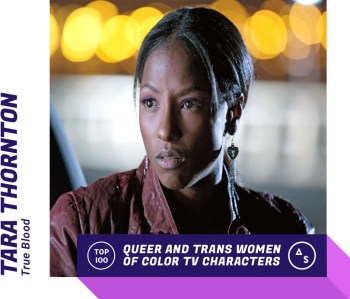 I will always remember when Tara Thornton came out dating a woman about halfway through True Blood’s run — it spread through my QTPOC social circle like wildfire. Most of us were already watching True Blood, thanks in no small part to Tara’s cousin Lafayette (who for my money remains one of the most important queer black men in all of television, RIP Nelsan Ellis). Tara coming out just felt right, you know? And yes, Tara also had a great whirlwind romance with Pam, her maker. But that queer kinship she shared with Lafayette? Damn, that felt like home. — Carmen
I will always remember when Tara Thornton came out dating a woman about halfway through True Blood’s run — it spread through my QTPOC social circle like wildfire. Most of us were already watching True Blood, thanks in no small part to Tara’s cousin Lafayette (who for my money remains one of the most important queer black men in all of television, RIP Nelsan Ellis). Tara coming out just felt right, you know? And yes, Tara also had a great whirlwind romance with Pam, her maker. But that queer kinship she shared with Lafayette? Damn, that felt like home. — Carmen
30. Lena Adams Foster, The Fosters
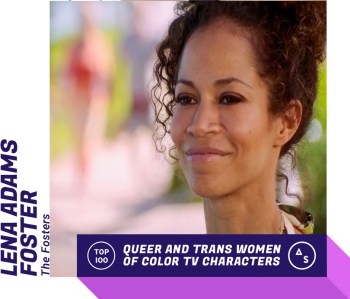 It’s not where you come from, it’s where you belong, and Lena Adams Foster made sure that she made a home for as many children who otherwise wouldn’t have had one as she could. Her generosity of spirit is what keeps us coming back to her as a model of how we could be living our own lives in a manner more loving, making sure we are using our various privileges to fight and protect those who are more vulnerable to systematic injustices and likely to fall through the cracks than we are. Lena’s brilliant, she’s kind, and just damn… what a Mom. — Carmen
It’s not where you come from, it’s where you belong, and Lena Adams Foster made sure that she made a home for as many children who otherwise wouldn’t have had one as she could. Her generosity of spirit is what keeps us coming back to her as a model of how we could be living our own lives in a manner more loving, making sure we are using our various privileges to fight and protect those who are more vulnerable to systematic injustices and likely to fall through the cracks than we are. Lena’s brilliant, she’s kind, and just damn… what a Mom. — Carmen
29. Tamia “Coop” Cooper, All American
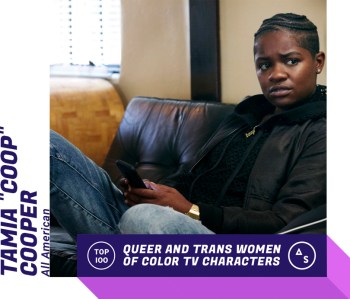 All American was supposed to be a show about football — a story is loosely based on the early football years of retired NFL player Spencer Paysinger — but during its first season, it also made room for Spencer’s best friend, Tamia “Coop” Cooper, to share the spotlight. She’s more than just the lesbian sidekick, at her best she’s the show’s co-lead: given consistent screen time, actual character development and a love interest that’s on equal footing with the show’s straight love interests. That much investment in a lesbian storyline is virtually unheard of… but for a black masculine of center lesbian? It’s unprecedented. — Natalie
All American was supposed to be a show about football — a story is loosely based on the early football years of retired NFL player Spencer Paysinger — but during its first season, it also made room for Spencer’s best friend, Tamia “Coop” Cooper, to share the spotlight. She’s more than just the lesbian sidekick, at her best she’s the show’s co-lead: given consistent screen time, actual character development and a love interest that’s on equal footing with the show’s straight love interests. That much investment in a lesbian storyline is virtually unheard of… but for a black masculine of center lesbian? It’s unprecedented. — Natalie
28. Brook Soso, Orange is the New Black
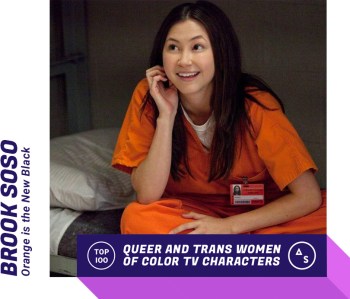 When Brook Soso first showed up at Litchfield, I think we can all agree she was a little bit annoying. She came across as privileged and isolated from the realities of the world around her. With time, however, what started off by feeling like a bad parody of “#WOKE” activism turns into something else entirely. Soso has a quiet strength at her core that’s hard to turn away from or not take seriously. She’s little, but damn she’s mighty. She shows us that non-violent resistance is never for the weak of heart. And hers is made out of pure steel. — Carmen
When Brook Soso first showed up at Litchfield, I think we can all agree she was a little bit annoying. She came across as privileged and isolated from the realities of the world around her. With time, however, what started off by feeling like a bad parody of “#WOKE” activism turns into something else entirely. Soso has a quiet strength at her core that’s hard to turn away from or not take seriously. She’s little, but damn she’s mighty. She shows us that non-violent resistance is never for the weak of heart. And hers is made out of pure steel. — Carmen
27. Anissa Pierce, Black Lightning
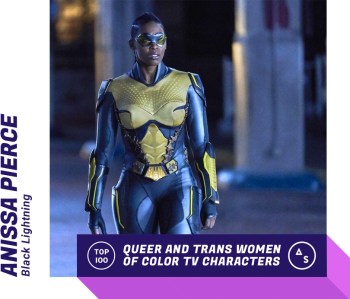 Nearly two years ago, history was made: Still reeling from a kidnapping earlier in the day, Anissa Pierce’s trauma turns into a panic attack that unleashes her previously dormant superpowers. In that moment, everything changed; it was the most prominent affirmation yet that queer women could be the heroes of their own stories. We had our first lesbian superhero on network television, our first black lesbian superhero ever. The game will never be the same. In the days since, Anissa has been growing fully into her destiny: The girl they used to nickname “Harriet” is rescuing metahumans and helping them escape persecution via her own version underground railroad. — Natalie
Nearly two years ago, history was made: Still reeling from a kidnapping earlier in the day, Anissa Pierce’s trauma turns into a panic attack that unleashes her previously dormant superpowers. In that moment, everything changed; it was the most prominent affirmation yet that queer women could be the heroes of their own stories. We had our first lesbian superhero on network television, our first black lesbian superhero ever. The game will never be the same. In the days since, Anissa has been growing fully into her destiny: The girl they used to nickname “Harriet” is rescuing metahumans and helping them escape persecution via her own version underground railroad. — Natalie
26. Nico, Vida
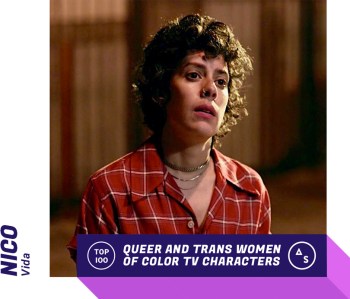 Nico’s an army vet, which rarely get to see on television. She’s a masc Latinx person — something else that’s not seen nearly enough. And more than all of that, she’s a genuinely good person. Nico walks into Emma Hernandez’s life at a time where having a support system couldn’t be more critical, and she rolls up her sleeves and gets to work. She helps Emma manage her family bar, and through her steady confidence and empathy, she finds her way into Emma’s heart. Roberta Colindrez has turned a supporting player role into something that feels lived in and absolutely unforgettable. — Carmen
Nico’s an army vet, which rarely get to see on television. She’s a masc Latinx person — something else that’s not seen nearly enough. And more than all of that, she’s a genuinely good person. Nico walks into Emma Hernandez’s life at a time where having a support system couldn’t be more critical, and she rolls up her sleeves and gets to work. She helps Emma manage her family bar, and through her steady confidence and empathy, she finds her way into Emma’s heart. Roberta Colindrez has turned a supporting player role into something that feels lived in and absolutely unforgettable. — Carmen
25. Tia Reed, Boomerang
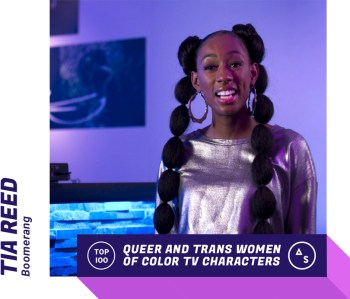 To truly understand how significant Tia Reed is on Boomerang, you have to first understand BET’s history. It is a network whose founder once banned the Kiss Cam at Washington Mystics games for fear that kids would see women kissing. It is a network that once muted the mere mention of us on its syndicated programming. When possible, BET has sought to render black queer people invisible. But then came Lena Waithe — fresh off her Emmy win — and Halle Berry with their spin-off of the 1992 classic movie, Boomerang, and everything changed. They didn’t just bring a lesbian character to BET when they gave us Tia Reed, they brought us a license to embrace and showcase our whole identity. — Natalie
To truly understand how significant Tia Reed is on Boomerang, you have to first understand BET’s history. It is a network whose founder once banned the Kiss Cam at Washington Mystics games for fear that kids would see women kissing. It is a network that once muted the mere mention of us on its syndicated programming. When possible, BET has sought to render black queer people invisible. But then came Lena Waithe — fresh off her Emmy win — and Halle Berry with their spin-off of the 1992 classic movie, Boomerang, and everything changed. They didn’t just bring a lesbian character to BET when they gave us Tia Reed, they brought us a license to embrace and showcase our whole identity. — Natalie
24. Nova Bordelon, Queen Sugar
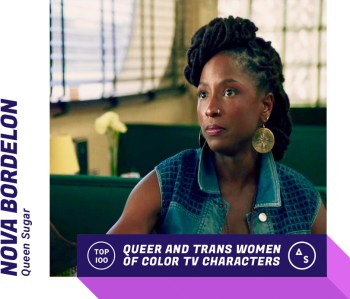 It’s really difficult to talk about the wild swings that have happened with Nova over the length of Queen Sugar. In it’s first season, she was arguably one of the best written, most grounded, relatable depictions of a black queer woman that we had seen up until that point in television. Unlike the rest of the Bordelon family members who came from the book upon which the series is based, Nova came directly from producer, director, and first season showrunner Ava DuVernay’s imagination. She was modeled to pay homage to the long legacy of black queer women writers and activists that make up the backbone of black radicalism and black community care. Somewhere along the way, things became almost irreparably muddled, but for one brief glimmering moment — Nova really did have it all. — Carmen
It’s really difficult to talk about the wild swings that have happened with Nova over the length of Queen Sugar. In it’s first season, she was arguably one of the best written, most grounded, relatable depictions of a black queer woman that we had seen up until that point in television. Unlike the rest of the Bordelon family members who came from the book upon which the series is based, Nova came directly from producer, director, and first season showrunner Ava DuVernay’s imagination. She was modeled to pay homage to the long legacy of black queer women writers and activists that make up the backbone of black radicalism and black community care. Somewhere along the way, things became almost irreparably muddled, but for one brief glimmering moment — Nova really did have it all. — Carmen
23. Santana Lopez, Glee
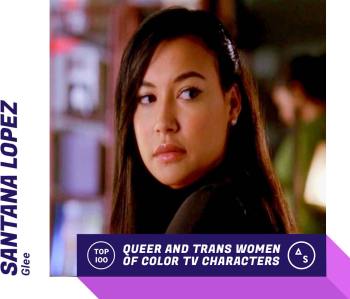 Autostraddle’s managing editor Heather Hogan once joked that Santana Lopez might very well be the most important lesbian character on television since Ellen Degeneres. Here’s the thing — I think she may be right. Before Santana, lesbians on TV were largely either evil villains or they were moral angels burdened with the weight of representing the entire community. Santana was a high school bully, and after she came out of the closet she largely remained a sharp tongued, tough edged, mean girl who you never wanted to cross. But she was also a teenage girl who learned how to hurt others because she was really hurting herself. She pulled back the glossy coating of the High School Cheerleader Bitch and inside she found a gay dork. She was allowed a breadth of character that’s now become commonplace, and I’m not sure if it would have happened without her. — Carmen
Autostraddle’s managing editor Heather Hogan once joked that Santana Lopez might very well be the most important lesbian character on television since Ellen Degeneres. Here’s the thing — I think she may be right. Before Santana, lesbians on TV were largely either evil villains or they were moral angels burdened with the weight of representing the entire community. Santana was a high school bully, and after she came out of the closet she largely remained a sharp tongued, tough edged, mean girl who you never wanted to cross. But she was also a teenage girl who learned how to hurt others because she was really hurting herself. She pulled back the glossy coating of the High School Cheerleader Bitch and inside she found a gay dork. She was allowed a breadth of character that’s now become commonplace, and I’m not sure if it would have happened without her. — Carmen
22. Kalinda Sharma, Good Wife
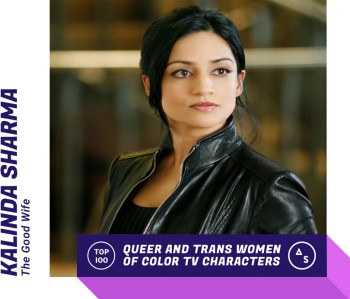 The Good Wife was supposed to be a star vehicle for Julianna Marguiles. Her first big series since she’d left her role on ERho. But a funny thing happened — a thing that hardly ever happens, if we’re being honest — Marguiles ended up playing second fiddle on her own show. Critics, the audience… everyone… gravitated instead to Archie Panjabi’s Kalinda Sharma, the badass bisexual private investigator at Lockhart Gardner. Kalinda was everything: strong, quick witted, manipulative (when necessary) and impeccably dress (oh, those knee-high boots!). Panjabi’s portrayal of Kalinda earned her — and the show — its first Emmy Award, much to the consternation of Marguiles, I’d imagine. — Natalie
The Good Wife was supposed to be a star vehicle for Julianna Marguiles. Her first big series since she’d left her role on ERho. But a funny thing happened — a thing that hardly ever happens, if we’re being honest — Marguiles ended up playing second fiddle on her own show. Critics, the audience… everyone… gravitated instead to Archie Panjabi’s Kalinda Sharma, the badass bisexual private investigator at Lockhart Gardner. Kalinda was everything: strong, quick witted, manipulative (when necessary) and impeccably dress (oh, those knee-high boots!). Panjabi’s portrayal of Kalinda earned her — and the show — its first Emmy Award, much to the consternation of Marguiles, I’d imagine. — Natalie
21. Elektra Wintour (Also Known as Elektra Abundance), Pose
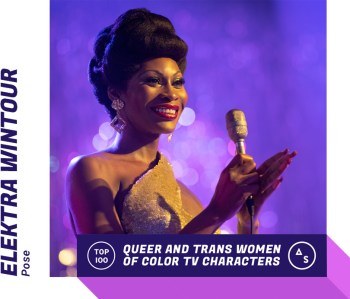 No one can read a line like Dominique Jackson. My girl can read the page to filth. She’ll take a deep breath and you already know your life is over before the first word leaves her perfectly painted mouth. Even when in the background, her comic timing pulls your attention. There isn’t a scene in Pose that isn’t better when she enters the room. What we don’t talk about enough, however, is the pathos she has found beneath Elektra’s cool bitch exterior. That’s truly what makes the character most memorable. — Carmen
No one can read a line like Dominique Jackson. My girl can read the page to filth. She’ll take a deep breath and you already know your life is over before the first word leaves her perfectly painted mouth. Even when in the background, her comic timing pulls your attention. There isn’t a scene in Pose that isn’t better when she enters the room. What we don’t talk about enough, however, is the pathos she has found beneath Elektra’s cool bitch exterior. That’s truly what makes the character most memorable. — Carmen
20. Bette Porter, The L Word
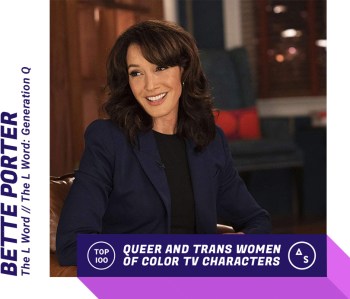 Yes, when one talks about Bette Porter one must mention what a hot top she is; one must mention how cathartic it feels to hear her say “Fuck;” her prototype Power Lesbian nature; maybe even her unfortunate propensity for cheating. Those are all in the Lesbian Television handbook. But do you know what I’ve always appreciated most about Bette Porter? In the original The L Word, she exists in a mostly white space — but Jennifer Beals never stopped advocating for her as a biracial black woman. We meet Bette’s (black) father. We love her (black) sister. One of the first things we learn about, back in the very beginning of Season One, is that its important to her to have a black daughter. The writers of The L Word created a world that was largely defined by its overwhelming whiteness, but even when it would have been easy for Bette Porter to slip into the background of that framework, Jennifer Beals made sure that she never did. — Carmen
Yes, when one talks about Bette Porter one must mention what a hot top she is; one must mention how cathartic it feels to hear her say “Fuck;” her prototype Power Lesbian nature; maybe even her unfortunate propensity for cheating. Those are all in the Lesbian Television handbook. But do you know what I’ve always appreciated most about Bette Porter? In the original The L Word, she exists in a mostly white space — but Jennifer Beals never stopped advocating for her as a biracial black woman. We meet Bette’s (black) father. We love her (black) sister. One of the first things we learn about, back in the very beginning of Season One, is that its important to her to have a black daughter. The writers of The L Word created a world that was largely defined by its overwhelming whiteness, but even when it would have been easy for Bette Porter to slip into the background of that framework, Jennifer Beals made sure that she never did. — Carmen
19. Kat Edison, The Bold Type
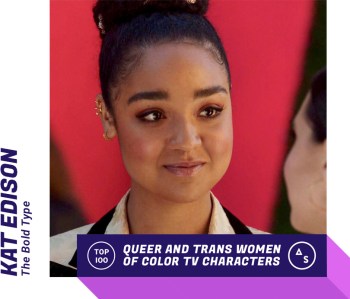 Kat’s high ranking on this list is nothing short of a marvel. When The Bold Type began, Kat was uncharacteristically unaware of her own blackness. She baffled and upset a lot of us — how could a politically engaged, 20something, social media editor of a magazine not unlike Teen Vogue be so ignorant about the ways her race effects her day-to-day world. What’s remarkable about The Bold Type is that they heard our complaints — and they worked towards fixing it. Now Kat’s bold and assured in her identity. She becomes the kind of woman who works through the complications of her blackness and her head-first approach to confronting racism with a black girlfriend who believes in taking a different approach. And neither of them is framed as wrong! Because there is no right answer on how to be a young queer black woman in America. There’s just growth. And few people have grown as much in these last few years as Kat. — Carmen
Kat’s high ranking on this list is nothing short of a marvel. When The Bold Type began, Kat was uncharacteristically unaware of her own blackness. She baffled and upset a lot of us — how could a politically engaged, 20something, social media editor of a magazine not unlike Teen Vogue be so ignorant about the ways her race effects her day-to-day world. What’s remarkable about The Bold Type is that they heard our complaints — and they worked towards fixing it. Now Kat’s bold and assured in her identity. She becomes the kind of woman who works through the complications of her blackness and her head-first approach to confronting racism with a black girlfriend who believes in taking a different approach. And neither of them is framed as wrong! Because there is no right answer on how to be a young queer black woman in America. There’s just growth. And few people have grown as much in these last few years as Kat. — Carmen
18. Mary Charles “M-Chuck” Calloway, Survivor’s Remorse
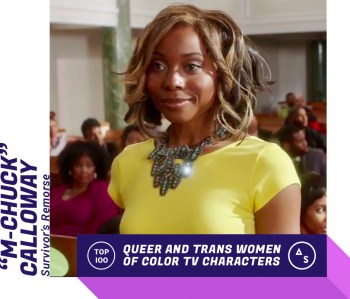 If you missed out on watching Survivor’s Remorse when it first aired — first of all, you are far from alone. Second, you missed your opportunity to get to know arguably the best lesbian character we’ve ever seen in a sitcom in the last decade or more. Why is M-Chuck so great, you may ask? It’s because her sexuality is never sidestepped — her conquests are legendary and there isn’t a woman she can’t figure out how to get in her bed. It’s also because she’s utterly and completely loved by her crazy family. They never ask her to make herself smaller or quieter when it’s so clear she was born to light up a room. Finally, she’s never asked to check her blackness at the door. M-Chuck was one of the only (and continues to be one of the few) fully developed black queer characters who was allowed to live in a black space without questions or parameters. Everything about her was a breath of fresh air. — Carmen
If you missed out on watching Survivor’s Remorse when it first aired — first of all, you are far from alone. Second, you missed your opportunity to get to know arguably the best lesbian character we’ve ever seen in a sitcom in the last decade or more. Why is M-Chuck so great, you may ask? It’s because her sexuality is never sidestepped — her conquests are legendary and there isn’t a woman she can’t figure out how to get in her bed. It’s also because she’s utterly and completely loved by her crazy family. They never ask her to make herself smaller or quieter when it’s so clear she was born to light up a room. Finally, she’s never asked to check her blackness at the door. M-Chuck was one of the only (and continues to be one of the few) fully developed black queer characters who was allowed to live in a black space without questions or parameters. Everything about her was a breath of fresh air. — Carmen
17. Emily Fields, Pretty Little Liars
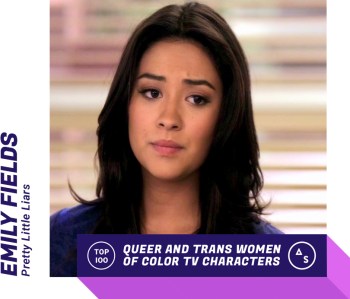 Emily Fields is the girl next door who you grow up with, and never quite forget about once you leave for college. The girl you find yourself Instagram stalking that one night when you have Insomnia and it turns out that she’s doing just fine — she has a wife, a career. And you feel deeply satisfied knowing that even though your paths parted ways, she found her own happiness out there. There was a lot about Pretty Little Liars that boggles the mind in retrospect. It’s hard to even explain to be people the inside joke and non-sensical plot twists that helped define us a queer TV watchers for the first half of the decade. But there will always be Emily Fields, there with the glass in her hair. — Carmen
Emily Fields is the girl next door who you grow up with, and never quite forget about once you leave for college. The girl you find yourself Instagram stalking that one night when you have Insomnia and it turns out that she’s doing just fine — she has a wife, a career. And you feel deeply satisfied knowing that even though your paths parted ways, she found her own happiness out there. There was a lot about Pretty Little Liars that boggles the mind in retrospect. It’s hard to even explain to be people the inside joke and non-sensical plot twists that helped define us a queer TV watchers for the first half of the decade. But there will always be Emily Fields, there with the glass in her hair. — Carmen
16. Annalisa “Quiet Ann” Zayas, Claws
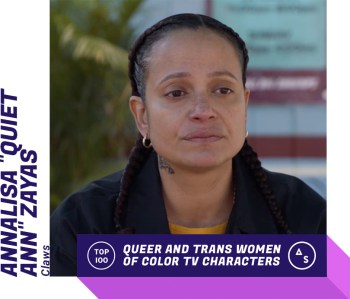 “They call me Quiet Ann because I don’t talk much,” Annalisa Zayas admits. While get glimpses into her backstory — she’s a polyglot who was once married to a professor — Ann spends most of the first season in silence, quietly posted up outside the nail salon, acting as security, or diligently handling whatever crisis her crew have created, often without acknowledgement. She was, in effect, a plot device…a particularly disappointing fate for a rare butch Latina on television. But in Season 2 of Claws, Ann comes out with a scream: Vocalizing her opinions, even if it causes friction within the crew, and asserting her right to prioritize her own happiness. — Natalie
“They call me Quiet Ann because I don’t talk much,” Annalisa Zayas admits. While get glimpses into her backstory — she’s a polyglot who was once married to a professor — Ann spends most of the first season in silence, quietly posted up outside the nail salon, acting as security, or diligently handling whatever crisis her crew have created, often without acknowledgement. She was, in effect, a plot device…a particularly disappointing fate for a rare butch Latina on television. But in Season 2 of Claws, Ann comes out with a scream: Vocalizing her opinions, even if it causes friction within the crew, and asserting her right to prioritize her own happiness. — Natalie
15. Tegan Price, How to Get Away With Murder
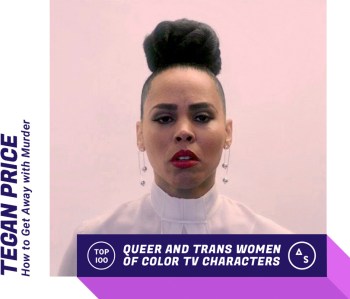 Tegan Price started out as ancillary character: An opening for her mentee, Michaela Pratt, and her band of murderous marauders to access the Antares files and get the information they needed to avenge Wes’ death (or “death”… I’m not sure which). Slowly but surely, How to Get Away With Murder has added layers to her character — she’s ambitious, she’s a lesbian, she’s an orphan, she’s married — and in doing so they created a compelling and unprecedented juxtaposition between her story and Annalise’s never before seen between two black queer women on television. — Natalie
Tegan Price started out as ancillary character: An opening for her mentee, Michaela Pratt, and her band of murderous marauders to access the Antares files and get the information they needed to avenge Wes’ death (or “death”… I’m not sure which). Slowly but surely, How to Get Away With Murder has added layers to her character — she’s ambitious, she’s a lesbian, she’s an orphan, she’s married — and in doing so they created a compelling and unprecedented juxtaposition between her story and Annalise’s never before seen between two black queer women on television. — Natalie
14. Callie Torres, Grey’s Anatomy
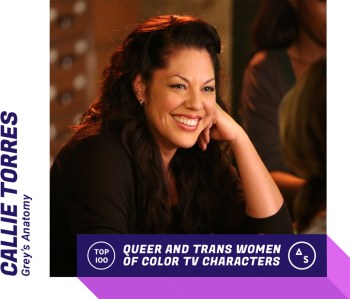 My forever beloved Calliope Iphegenia Torres. If for some reason you don’t already know, Callie Torres is the longest-running queer television character in network TV history, appearing in 11 seasons and 239 episodes of Grey’s Anatomy. More importantly, she’s played by none other than our greatest bi-con, political activist and Tony Award winner Sara Ramirez. Callie’s so loved by so many queer women that when Natalie and I realized she hadn’t quite made the Top Ten we checked the numbers twice — and then we still checked them once more! What Sara Ramirez accomplished with Callie Torres is fundamentally groundbreaking. In that way, we see their current ranking as an honor. So many of the names that are coming up wouldn’t have even been a dream possible if they hadn’t been there first.— Carmen
My forever beloved Calliope Iphegenia Torres. If for some reason you don’t already know, Callie Torres is the longest-running queer television character in network TV history, appearing in 11 seasons and 239 episodes of Grey’s Anatomy. More importantly, she’s played by none other than our greatest bi-con, political activist and Tony Award winner Sara Ramirez. Callie’s so loved by so many queer women that when Natalie and I realized she hadn’t quite made the Top Ten we checked the numbers twice — and then we still checked them once more! What Sara Ramirez accomplished with Callie Torres is fundamentally groundbreaking. In that way, we see their current ranking as an honor. So many of the names that are coming up wouldn’t have even been a dream possible if they hadn’t been there first.— Carmen
13. Shakima Greggs, The Wire
 Shakima Greggs very well may have been the first black lesbian I saw on television. The homicide detective often was the moral center of a show that famously dealt in grays far more than it ever did in black or white. Sometimes that also meant she was regulated to the sidelines of the main plot, but more often than not Kima was holding it down on her own. There are few portrayals of cops on television that I can get behind, but for Kima I’m willing to make an exception. — Carmen
Shakima Greggs very well may have been the first black lesbian I saw on television. The homicide detective often was the moral center of a show that famously dealt in grays far more than it ever did in black or white. Sometimes that also meant she was regulated to the sidelines of the main plot, but more often than not Kima was holding it down on her own. There are few portrayals of cops on television that I can get behind, but for Kima I’m willing to make an exception. — Carmen
12. Blanca Evangelista, Pose
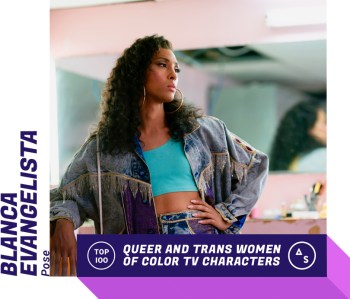 Any day that I get to sing Mj Rodriguez’s praises is a good day in my book. Pose is a once in a generation story, and so much of it falls on her shoulders to carry as the emotional engine of the entire production. It’s not a coincidence that Pose began with Blanca’s HIV diagnosis, with her desire to leave her mark on this world and create a family of her own. In those early episodes in particular, Pose worked because she WERKED AT IT. Much like Blanca, Mj doesn’t give up. If there’s a tear to be wrung out of an eye, she’s there. If there’s a punchline of a joke waiting for someone to hit it — look no further. And what about a musical number while we are at it? Blanca is the heart of her family, but Mj — she is the heart of ours. — Carmen
Any day that I get to sing Mj Rodriguez’s praises is a good day in my book. Pose is a once in a generation story, and so much of it falls on her shoulders to carry as the emotional engine of the entire production. It’s not a coincidence that Pose began with Blanca’s HIV diagnosis, with her desire to leave her mark on this world and create a family of her own. In those early episodes in particular, Pose worked because she WERKED AT IT. Much like Blanca, Mj doesn’t give up. If there’s a tear to be wrung out of an eye, she’s there. If there’s a punchline of a joke waiting for someone to hit it — look no further. And what about a musical number while we are at it? Blanca is the heart of her family, but Mj — she is the heart of ours. — Carmen
11. Rosa Diaz, Brooklyn 99
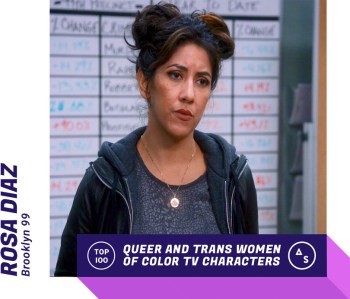 According to an estimate by the Williams Institute, bisexual+ people make up a majority of the LGB community and yet, when it comes to the representation of bisexual+ people on television, only 26% of the LGBT characters are bisexual. But in Brooklyn 99‘s fifth season we were gifted with the bisexual representation we deserve when the precinct’s tough-as-nails detective Rosa Diaz came out as bisexual. In an era where labels are often eschewed — however unwittingly contributing to bi erasure — Rosa actually says the word bisexual out loud and embraces the identity for herself. The success of Rosa’s coming out story is thanks, in large part, to input from her portrayer, bisexual actress Stephanie Beatriz, and it should be a model for every other show. — Natalie
According to an estimate by the Williams Institute, bisexual+ people make up a majority of the LGB community and yet, when it comes to the representation of bisexual+ people on television, only 26% of the LGBT characters are bisexual. But in Brooklyn 99‘s fifth season we were gifted with the bisexual representation we deserve when the precinct’s tough-as-nails detective Rosa Diaz came out as bisexual. In an era where labels are often eschewed — however unwittingly contributing to bi erasure — Rosa actually says the word bisexual out loud and embraces the identity for herself. The success of Rosa’s coming out story is thanks, in large part, to input from her portrayer, bisexual actress Stephanie Beatriz, and it should be a model for every other show. — Natalie
10. Annalise Keating, How to Get Away With Murder
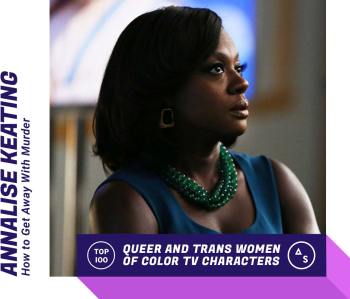 There’s a scene in the first season of How to Get Away With Murder, where you get to watch Viola Davis’ Annalise take off all her armor — her jewelry, her wig, her eyelashes and her makeup — and then she turns to her husband and asks, bluntly, “why is your penis on a dead girl’s phone?” It’s the moment you know, without a shadow of a doubt, that Viola Davis is going to win an Emmy and that Annalise Keating was going to be game-changing representation for black women. And then, at the height of the character’s popularity and just after Viola collected that Emmy, Pete Nowalk said, “let’s make her queer.” That was a game changing moment for black queer women, who’d never seen themselves featured so prominently on television before. — Natalie
There’s a scene in the first season of How to Get Away With Murder, where you get to watch Viola Davis’ Annalise take off all her armor — her jewelry, her wig, her eyelashes and her makeup — and then she turns to her husband and asks, bluntly, “why is your penis on a dead girl’s phone?” It’s the moment you know, without a shadow of a doubt, that Viola Davis is going to win an Emmy and that Annalise Keating was going to be game-changing representation for black women. And then, at the height of the character’s popularity and just after Viola collected that Emmy, Pete Nowalk said, “let’s make her queer.” That was a game changing moment for black queer women, who’d never seen themselves featured so prominently on television before. — Natalie
9. Suzanne Warren, Orange is the New Black
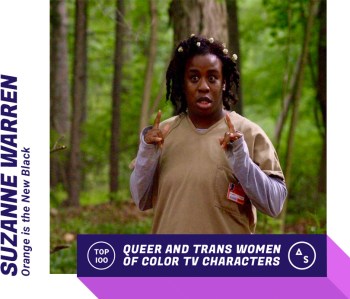 When Orange is the New Black first began, Suzane “Crazy Eyes” Warren was depicted as a joke. A take on the ways that the prison industrial complex fails to serve those with mental illness. A supposedly sexually undesirable black queer character to hit on the conventionally attractive white woman lead. Well, Uzo Aduba had other plans. She found humanity in Suzane that by the end of the first season, calling her “Crazy Eyes” felt absolutely wrong in our bones. She found such depth that she went on to win Emmys in both the comedic and drama races — also becoming the first actress to win multiple Emmys for playing a queer woman. — Carmen
When Orange is the New Black first began, Suzane “Crazy Eyes” Warren was depicted as a joke. A take on the ways that the prison industrial complex fails to serve those with mental illness. A supposedly sexually undesirable black queer character to hit on the conventionally attractive white woman lead. Well, Uzo Aduba had other plans. She found humanity in Suzane that by the end of the first season, calling her “Crazy Eyes” felt absolutely wrong in our bones. She found such depth that she went on to win Emmys in both the comedic and drama races — also becoming the first actress to win multiple Emmys for playing a queer woman. — Carmen
8. Elena Alvarez, One Day At A Time
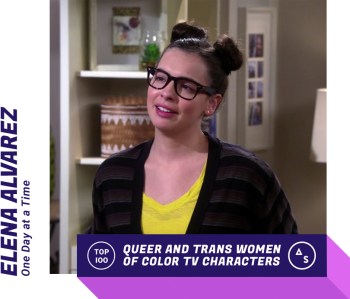 The best thing I can tell you about Elena Alvarez, at this very moment, is that we’ll get to see her again. We’ll get to see her relationship with Syd continue. We’ll get to see her deal with teenage angst (actually, I’m maybe not looking forward to that part). We’ll get to see her go to prom (I hope another promposal is in our future). We’ll get to see her make decisions about her future and pick a college. We’ll get to see her quirky, full-hearted self again…and, for a while, I was worried that we wouldn’t get to see any of that. When Netflix cancelled One Day at a Time back in March, it looked like we’d miss out on some great moments in Elena’s life… but the TV Gods interceded and Pop TV saved the day. We’ll get to hang out with Elena and the entire Alvarez family again when they make their cable television debut in March 2020. — Natalie
The best thing I can tell you about Elena Alvarez, at this very moment, is that we’ll get to see her again. We’ll get to see her relationship with Syd continue. We’ll get to see her deal with teenage angst (actually, I’m maybe not looking forward to that part). We’ll get to see her go to prom (I hope another promposal is in our future). We’ll get to see her make decisions about her future and pick a college. We’ll get to see her quirky, full-hearted self again…and, for a while, I was worried that we wouldn’t get to see any of that. When Netflix cancelled One Day at a Time back in March, it looked like we’d miss out on some great moments in Elena’s life… but the TV Gods interceded and Pop TV saved the day. We’ll get to hang out with Elena and the entire Alvarez family again when they make their cable television debut in March 2020. — Natalie
7. Angel Evangelista, Pose
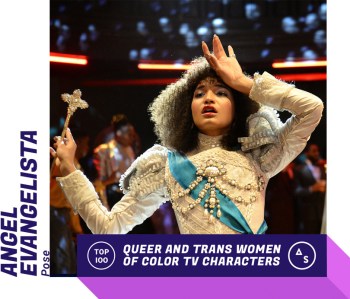 It was probably a given that someone from Pose would end up in our Top Ten, but to be honest with you — I had all my money on Blanca. However, there really are no losers in this battle. Pose’ success in front of and behind the camera is for black and brown trans women, for black and brown queer communities. Their wins are on some level, ours. For that we should all feel triumphant. Never before have QTPOC chosen families been showcased in such exquisite detail and reality. It’s for us, by us, in a way that very little other television ever has been. And Indya Moore as Angel? They’re everythaaaang — both in front and behind the camera. When Angel enters the scene, you can’t take your eyes off of her. She keeps you mesmerized. In their life away from the show, Indya Moore has used their platform to advocate for trans women and gender non-conforming femmes of color. They know that what we’re trying to accomplish here is about the broader team, the greater community. They have no interest in being the only one in the room if they can use the mic to make room for a sibling instead. And that’s why we stan. — Carmen
It was probably a given that someone from Pose would end up in our Top Ten, but to be honest with you — I had all my money on Blanca. However, there really are no losers in this battle. Pose’ success in front of and behind the camera is for black and brown trans women, for black and brown queer communities. Their wins are on some level, ours. For that we should all feel triumphant. Never before have QTPOC chosen families been showcased in such exquisite detail and reality. It’s for us, by us, in a way that very little other television ever has been. And Indya Moore as Angel? They’re everythaaaang — both in front and behind the camera. When Angel enters the scene, you can’t take your eyes off of her. She keeps you mesmerized. In their life away from the show, Indya Moore has used their platform to advocate for trans women and gender non-conforming femmes of color. They know that what we’re trying to accomplish here is about the broader team, the greater community. They have no interest in being the only one in the room if they can use the mic to make room for a sibling instead. And that’s why we stan. — Carmen
6. Denise, Master of None
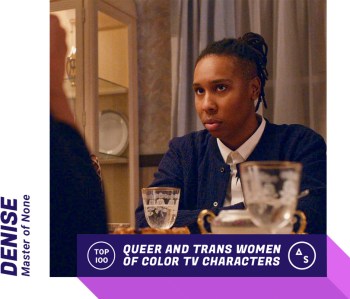 It is easy, when we talk about Denise and Master of None, to pair her entire story down to that one special episode: the Thanksgiving episode. The episode that cataloged ten years of friendship between Dev and Denise and ten years of Denise coming out to herself, her best friend and her family. The episode that gave Lena Waithe her first Emmy. But there’s more to the character than just that episode: There’s the Denise that earns equal footing among her four person friend group and who balances out the guys’ dating laments with reminds of what it means to be a woman. She’s funny, charming charismatic and really good at servicing women (“I can make a woman come more times in 20 minutes than she has in the last six months”)… which explains how she ends up with both Nikki and Michelle in “Thanksgiving.”— Natalie
It is easy, when we talk about Denise and Master of None, to pair her entire story down to that one special episode: the Thanksgiving episode. The episode that cataloged ten years of friendship between Dev and Denise and ten years of Denise coming out to herself, her best friend and her family. The episode that gave Lena Waithe her first Emmy. But there’s more to the character than just that episode: There’s the Denise that earns equal footing among her four person friend group and who balances out the guys’ dating laments with reminds of what it means to be a woman. She’s funny, charming charismatic and really good at servicing women (“I can make a woman come more times in 20 minutes than she has in the last six months”)… which explains how she ends up with both Nikki and Michelle in “Thanksgiving.”— Natalie
5. Leila, The Bisexual
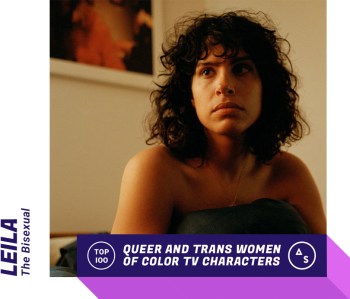 Desiree Akhavan designed The Bisexual to make us uncomfortable. She has no interest in clear, easy to define lines. No interest in writing queer heroes. She’d rather the muck of truth over the sheen of perfection. Maybe that doesn’t seem like a character we’d rank in the Top Five, but I can’t imagine a better reason for Leila to be here. Leila doesn’t have sex with a man one night and wake up the next morning as a fully formed bisexual role model, confident in her identity as a person who’s attracted to more than one gender, ready to lead the charge to banish erasure and champion inclusion. She doesn’t even want to use the word “bisexual.” She’s grappling with herself, and her friends. That’s relatable and holding such a cracked and dirty mirror in front of ourselves is supposed to make us itch a bit in our chairs. Job well done. — Carmen
Desiree Akhavan designed The Bisexual to make us uncomfortable. She has no interest in clear, easy to define lines. No interest in writing queer heroes. She’d rather the muck of truth over the sheen of perfection. Maybe that doesn’t seem like a character we’d rank in the Top Five, but I can’t imagine a better reason for Leila to be here. Leila doesn’t have sex with a man one night and wake up the next morning as a fully formed bisexual role model, confident in her identity as a person who’s attracted to more than one gender, ready to lead the charge to banish erasure and champion inclusion. She doesn’t even want to use the word “bisexual.” She’s grappling with herself, and her friends. That’s relatable and holding such a cracked and dirty mirror in front of ourselves is supposed to make us itch a bit in our chairs. Job well done. — Carmen
4. Poussey Washington, Orange is the New Black
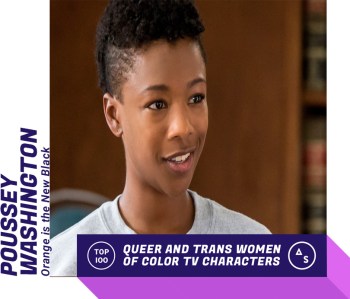 Poussey Washington is — hands down — one of the most beloved lesbian characters in television history. In fact, if Orange is the New Black hadn’t made the unforgivable decision to murder her at the hands of a prison guard in a severely mishandled attempt to understand the Black Lives Matter Movement, Poussey would have landed #1 on this very list — with room to spare. That’s how wonderfully she was written, how much warmth Samira Wiley brought to her role. Poussey’s death became a wound that wouldn’t heal because her life… her LIFE!… touched all of us. For that we will always be grateful. We knew how utterly special she was, even when Orange is the New Black did not. — Carmen
Poussey Washington is — hands down — one of the most beloved lesbian characters in television history. In fact, if Orange is the New Black hadn’t made the unforgivable decision to murder her at the hands of a prison guard in a severely mishandled attempt to understand the Black Lives Matter Movement, Poussey would have landed #1 on this very list — with room to spare. That’s how wonderfully she was written, how much warmth Samira Wiley brought to her role. Poussey’s death became a wound that wouldn’t heal because her life… her LIFE!… touched all of us. For that we will always be grateful. We knew how utterly special she was, even when Orange is the New Black did not. — Carmen
3. Sophia Burset, Orange is the New Black
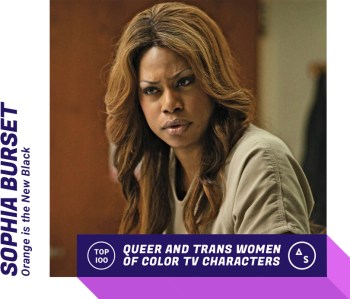 In an interview with Autostraddle soon after the release of Orange is the New Black‘s first season, Laverne Cox said, “I think the industry has to change and I think their ideas have to begin to change about who trans people are and what it means to have trans folks playing ourselves and playing characters that are written as trans on television. Hopefully [OITNB] will change the game of it in those terms.” Now, with the benefit of hindsight, there’s no doubt that Cox’s Emmy nominated portrayal of Sophia Burset — the former firefighter who committed fraud to access the healthcare she needed — was absolutely the gamechanger that Cox had hoped it would be. — Natalie
In an interview with Autostraddle soon after the release of Orange is the New Black‘s first season, Laverne Cox said, “I think the industry has to change and I think their ideas have to begin to change about who trans people are and what it means to have trans folks playing ourselves and playing characters that are written as trans on television. Hopefully [OITNB] will change the game of it in those terms.” Now, with the benefit of hindsight, there’s no doubt that Cox’s Emmy nominated portrayal of Sophia Burset — the former firefighter who committed fraud to access the healthcare she needed — was absolutely the gamechanger that Cox had hoped it would be. — Natalie
2. Eddy Martinez, Vida
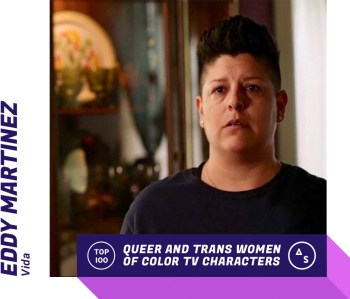 In the last two years, Ser Anzoátegui has almost completely redefined what we think of when we remember soft butches on TV. Eddy Martinez is tough, but full of raw emotion. She’s soft spoken when others might be loud. She takes care of her family, her bar. She mourns her wife. More than anything — she feels like someone you already know. Outside of queer communities, butches are known for their supposedly hard exterior, but we know the masc caretakers in our lives and how valued they are. In Eddy, Vida highlights that specific dynamic in perfect form. — Carmen
In the last two years, Ser Anzoátegui has almost completely redefined what we think of when we remember soft butches on TV. Eddy Martinez is tough, but full of raw emotion. She’s soft spoken when others might be loud. She takes care of her family, her bar. She mourns her wife. More than anything — she feels like someone you already know. Outside of queer communities, butches are known for their supposedly hard exterior, but we know the masc caretakers in our lives and how valued they are. In Eddy, Vida highlights that specific dynamic in perfect form. — Carmen
1. Emma Hernandez, Vida
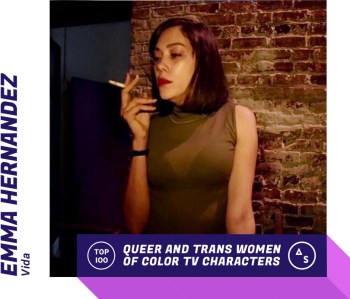 It’s funny — when we started this project, I expected Callie Torres to be #1. Or perhaps Annalise Keating. Definitely maybe Bette Porter. For while I even wondered if Santana Lopez could pull it off. There have been so many iconic queer women of color on TV in the last 20 years. But in retrospect, of course we landed here. It was always going to be Emma. Emma, who is richly drawn by queer Latina writer and showrunner Tanya Saracho. Emma, who Mishel Prada has imbued with hard edges and tangles of complicated emotions threatening to unravel and drown her at every turn. Back in 1999, when the idea of being able to rank 100 queer and trans women of color television would have been positively laughable, Latina writer Ana Castillo proclaimed that she wanted someone who could peel her love like an onion — layer by pungent, sticky, overwhelming layer. That’s Emma. She’s almost impossible to like at first, an ice bitch extraordinaire, but more than that she’s impossible not to root for. It’s fitting that the person to top this list actually isn’t perfect at all. Queerness is messy as fuck. So is Emma, and that’s why today we shall crown her our queen. — Carmen
It’s funny — when we started this project, I expected Callie Torres to be #1. Or perhaps Annalise Keating. Definitely maybe Bette Porter. For while I even wondered if Santana Lopez could pull it off. There have been so many iconic queer women of color on TV in the last 20 years. But in retrospect, of course we landed here. It was always going to be Emma. Emma, who is richly drawn by queer Latina writer and showrunner Tanya Saracho. Emma, who Mishel Prada has imbued with hard edges and tangles of complicated emotions threatening to unravel and drown her at every turn. Back in 1999, when the idea of being able to rank 100 queer and trans women of color television would have been positively laughable, Latina writer Ana Castillo proclaimed that she wanted someone who could peel her love like an onion — layer by pungent, sticky, overwhelming layer. That’s Emma. She’s almost impossible to like at first, an ice bitch extraordinaire, but more than that she’s impossible not to root for. It’s fitting that the person to top this list actually isn’t perfect at all. Queerness is messy as fuck. So is Emma, and that’s why today we shall crown her our queen. — Carmen
Pages: 1 2See entire article on one page



I love that this list exists 💚 Also apparently I really need to find out how to watch Vida here!
All this media content makes me fee like I’m running up a mountain side against an avalanche of shows I’ll never have time to watch
Same. But it’s a good problem to have
Pssst, you’ve got Elektra in the The L Word in the aughts where she’d likely be a senior citizen since she was Pose-ing in the 80s.
THANK YOU! Fixed!
Thanks for catching that, @liagd.
Now I really want Elektra as a senior citizen on the L-Word.
I said it earlier in the week, but Elektra is a bi-sexual top & nothing will change my mind about that.
Just think of me as a little Canary happily twittering to myself, as I find Sandy Lopez or Natalia Rivera, or even Kima or Shaw on this list!
Also, may I pretend that y’all were sitting behind a table holding up score cards, Pose style?
“May I present to you Captain Philippa Geourgiou? Watch that walk and those outfits!Work it, girl!Give me that roundhouse kick and self assured flirtation across three galaxies!”
OH, I WISH.
I am going to write a STRONGLY worded letter to SOMEONE about my wife Callie Torres not being number one!!!!!!!!!!!!!!
ME AND YOU BOTH! (except I am sorry to tell you that Calliope Iphegenia Torres is my wife.)
I -Can’t-Hear-Suddenly-dot-Mariah-dot-gif
I thought for sure Callie would be #1 and I was thwarted by my own metrics.
Emma! Emma! Emma! My girl is about to top two lists!
Arthieeeeeeeee
Also Edieeeeeeee
*Eddieeeeee
Hi! I respect what you are saying here (by the way I’m also multiracial, as is my co-writer on the piece, we would never disrespect multiracial identities).
However, Maggie Sawyer was explicitly written as a Mexican-American or Latinx character. Floriana Lima has stated herself that she is not; she identifies as Italian. For further clarification, Spanairds and Portuguese people are not Latinx…. in fact, they are the people who colonized us. So, as you can see, it’s definitely not the same thing. And if anything, it’s a little offensive.
Again though, I appreciate your time in reading the list. We’re very proud of our work on it. I don’t want to derail our work by continuing on this particular path, which can be very touchy for fans especially. And I understand why! My problem is with Maggie Sawyer’s casting, and Supergirl’s decision not to change the character’s backstory in light of that casting. I’m not trying to attack her character. As I said in the list itself, I think she was a good girlfriend for Alex.
We do appreciate you. Thanks for reaching out!
Thank you for explaining your point of view. My vex was that you called her “a white actor”. As a multiracial person it just hurts my identity when people erase the other parts of me. And in the media especially that happens a lot- Bi and Multi racial people are either too this or too that for either side and it feels like we have no place to belong. I’m sure you didn’t mean to do that, so I just wanted to share my pain about it.
Thank you for explaining your point of view. That makes sense. My vex was really that you called her a white actor. As a multiracial person it just hurts my identity when people erase the other parts of me. In the media especially that happens a lot- Bi and Multi racial people are either “too this” or “too that” for either side and it feels like we have no place to belong. I’m sure you didn’t mean to do that, so I just wanted to share my pain about it.
Also! I really really love this list and I’m glad it exists! Thank you all for making it <3
I just can’t fathom why Soso From OITNB is higher than Sameen Shaw. That is blasphemous on every level that exists.
Yes there are plenty of characters here whose descriptions I agree with, but I would never put above the complexity of Shaw’s character.
Great list though
Yes! Thank you!
Or Maggie Sawyer. Or Yolanda from GLOW, who I love as a character, but who doesn’t really get very many lines overall and no character growth whatsoever. And Arthie, tbh, who also gets very few lines. She comes out, sure, which is really sweet, but her gf breaks up with her because she won’t ID as “gay”? Or any of the superhero characters, esp from Black Lightning, who are frankly not well-served by the writing. And Cruz?
I’ve noticed the ratings here tend to slant a bit towards more “soapy” stuff – that’s fine! – and while Shaw and Root had a unique relationship, it’s definitely not as romo as some would like. And, well, there could have been more makeout sessions, although at least they got a funny and hot sex scene.
Of course this is all subjective, but I really think characters that have some kind of arc deserve to be higher up in the ranks. Shaw is a total badass, represents neurodivergent people, and also grows as a *person*. She’s also in a ton of eps, actually moves the plot along at a number of points, etc etc. And she’s literally the last person standing at the end of the show. >sigh<
I miss Ximena SinFuego so much & the fact that The Fosters (of all shows) queerbaited us with her & Callie was so maddening.
Thank you for making this list & commentary!! I can only imagine how much labor went into this.
My gosh, what a beautiful list! So many characters that I love and even more that I’d like to know.
Also, I nearly yelped when I saw Natalia Rivera on this list. She started out as a maid with an accent and a secret (spoiler: a kid) and ended up accent-less and rubbing foreheads with Olivia. Otalia seems like a lifetime ago.
Baby Ser is too cute I was not prepared.
Thank you for including Iranian & Arab characters in this. It solidifies how I never really felt comfortable putting down white on forms(there usually isn’t a west Asian/swana/middle east option. Side note, I recently found out this was related to avoiding discrimination in the housing market in the post-WWII era in the US. Related note, I still think Illene needs to be criticized for her choice of having Indian/Hindu(Papi) & Iranian(Carmen) women playing Latinx instead of West & Central Asian. Would have felt more authentic to me.
I know I am one of a few but thank you for including Kennedy from Buffy. I liked her character. Also I miss the Wire
The character wasn’t Latina. She was Italian/ Jewish, as you said.
It’s not just about “offense” tho.
In America there’s this ugly history of studios casting Latin or Hispanic people in only minor roles as servants or thugs and flat out REFUSING to consider or hire them for main cast or main character roles and casting Italian or Sicilian Americans when there was a Hispanic main character or main cast character.
Yeah okay yes Maggie Sawyer was a blue eyed blonde WASP in one of her incarnations, but in her most recent she’s metiza.
So Italian-American Floriana Lima’s casting aggravates an unhealed wound for Latin and Hispanic people in America especially actors who are still experiencing marginalization in their field in addition to all the go back to where you came from/you’re not a REAL American nonsense.
Positive rep is very thin here and to have the chance to rep taken by someone who doesn’t experience the issues you face and missing out on a job hurts.
Can you understand that?
The thing with North America is that its population is not homogenous. We have people of many different backgrounds living here, but our media largely does not reflect that, and instead focuses predominantly on straight, cis, white people (mostly men). It often ignores entire chunks of the population. And in a society where racism and xenophobia are still huge problems, positive, accurate depictions of people from a variety of backgrounds is extremely important.
this post gets into the legacy of this situation as of 2016:
https://www.autostraddle.com/2016-oscars-so-so-so-white-329290/
Your post is a whole mess!
First you say “I am sorry” in a “No offense, but I am gonna say some offensive shit” kind of way and then go off on what I assume is her behaviour on Twitter and while criticizing her for not conforming to your opinion expect her to conform to yours at the same time?
The whole ethnicity of the original character and the open casting is totally beside the point!
The fact that the character of Maggie Sawyer is originally white doesn’t mean that the people in charge of Supergirl were right to redefine her character as a person of colour and stil have a white woman play her. Just as it wouldn’t have been right to have Jimmy Olsen be played by a white actor depsite being redefined as black!
And them having an open casting meant either a) they were always willing to have a white actor play a non-white part or b) when they cast Floriana Lima they decided they could get away with casting her as Latinx and changed her character’s ethnicity.
Carmen never says that the character itself doesn’t deserve to be on here or blames Floriana herself in this article, she just points out that white people playing people of colours is not okay anymore and wasn’t ever really okay and that’s why she personally disagrees with placing Maggie on this particular list.
I don’t really get where Carmen has incited hate or spread false stories and I can’t find any twitter convos that support these accusations. And I also am not sure to what controversial statement you are refering to since “its not okay for white people to play/act people of colour” is not and should not be a controversial statement!
As to the accusations of double standards, Carmen specifically mentions that Carmen de la Pica Morales is loved despite her flaws – chief amongst them not being played by a Latina – but also doesn’t specifically make that point that it isn’t okay for non-Latinx people to play Latinx people but rather that it isn’t okay for white people to play people of colour.
The difference between the two is that Sarah Shahi is biracial and from Iranian and Spanish descent while Floriana Lima is white and from wholly European/Caucasian descent and that makes a difference especially with Hollywood’s sordid history of white people playing people of colour that Riese mentions in a reply to a post below.
I’m so excited we now live in a world where a list like this can exist. And I’m so excited Autostraddle writers have their own collective!
“ When they rise to the occasion, nothing tops The Fosters”
So much truth here. Such a shame that show never got the recognition that they deserved
Pingback: Giro de Notícias – Cadê Minhas Lésbicas?
Pingback: Classic TV From the Bush Era That You Can Stream to Survive Trump This Year – Autostraddle – Lgbt Vibes Traps and Goals
Pingback: Classic TV From the Aughts That You Can Stream to Survive Trump This Year – Autostraddle – Lgbt Vibes Traps and Goals
Brooklyn & Sage from Utopia falls you guys!! Latina + Asian! w|w where have we seen that?!?!?!
Pingback: 32 Lesbian, Queer & Bisexual (LGBTQ+) TV Shows Streaming Free on Amazon Prime – T2F Media
we need an updated version of this! so many more shows have been featuring queer women of color this year